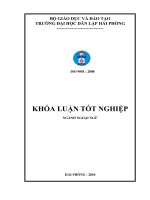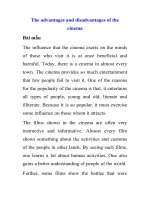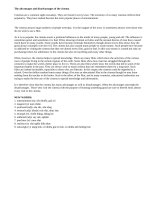A research on the advantages and disadvantages of the application of task-based approach in teaching speaking to the fisrt-year non-English major students at Hanoi University of Industry
Bạn đang xem bản rút gọn của tài liệu. Xem và tải ngay bản đầy đủ của tài liệu tại đây (131.7 KB, 4 trang )
VIET NAM NATIONAL UNIVERSITY, HANOI
UNIVERSITY OF LANGUAGES AND INTERNATIONAL STUDIES
FACULTY OF POST – GRADUATE STUDIES
PHẠM MAI KHÁNH
A RESEARCH ON THE ADVANTAGES AND
DISADVANTAGES OF THE APPLICATION OF TASKBASED APPROACH IN TEACHING SPEAKING TO THE
FIRST-YEAR NON-ENGLISH MAJOR STUDENTS AT
HANOI UNIVERSITY OF INDUSTRY
(Nghiên cứu những khó khăn và thuận lợi của việc áp dụng phương pháp
giao nhiệm vụ trong dạy nói cho sinh viên không chuyên năm thứ nhất
ở Trường Đại học Công nghiệp Hà Nội)
M.A. MINOR THESIS
Field: English Methodology
Code: 601410
Supervisor: Dr. To Thi Thu Huong
Hanoi - 2010
iv
TABLE OF CONTENTS
Page
Declaration....................................................................................................................................i
Acknowledgements......................................................................................................................ii
Abstract.......................................................................................................................................iii
Table of Contents........................................................................................................................iv
List of Abbreviations.................................................................................................................vii
List of tables.............................................................................................................................viii
List of figures............................................................................................................................viii
PART ONE: INTRODUCTION...............................................................................................1
1. Rationale for the study.............................................................................................................1
2. Aims of the study.....................................................................................................................2
3. Scope of the study....................................................................................................................2
4. Significance of the study..........................................................................................................2
5. Methods of the study................................................................................................................2
6. Structure of the study...............................................................................................................3
PART TWO: DEVELOPMENT..............................................................................................4
CHAPTER ONE: LITERATURE REVIEW..........................................................................4
1.1. Task-based language teaching..............................................................................................4
1.1.1. What is a task?.......................................................................................................4
1.1.2. Task types..............................................................................................................4
1.1.3. What is TBLT?......................................................................................................5
1.1.4. A framework for designing TB lessons.................................................................6
1.2. Speaking skill in language teaching......................................................................................8
1.2.1. What is speaking skill?..........................................................................................8
1.2.2. The importance of speaking skill in language teaching programs.........................8
1.3. Factors affecting TBLT application in speaking skill...........................................................9
1.3.1. Teachers.................................................................................................................9
1.3.1.1. Teachers’ attitudes and beliefs................................................................9
v
1.3.1.2. Teachers’ qualities and personalities.....................................................9
1.3.2. Learners...............................................................................................................10
1.3.2.1. Learners’ motivation............................................................................10
1.3.2.2. Learners’ attitudes and beliefs..............................................................10
1.3.2.3. Learners’ anxiety and confidence.........................................................10
1.3.3. Learning environment and Text books................................................................11
CHAPTER TWO: THE STUDY............................................................................................12
2.1. The context of the study......................................................................................................12
2.1.1. English language teaching at HaUI......................................................................12
2.1.2. The teaching materials and assessment................................................................13
2.1.3. Teachers and students..........................................................................................13
2.1.4. Teaching and learning facilities...........................................................................14
2.2. The research methodology..................................................................................................14
2.2.1. Research questions...............................................................................................14
2.2.2. The participants....................................................................................................15
2.2.3. Data collection instruments..................................................................................15
2.2.3.1. Questionnaire........................................................................................15
2.2.3.2. Class Observation.................................................................................16
2.2.3.3. Interviews..............................................................................................17
2.3. Data analysis methods.........................................................................................................17
2.3.1. The questionnaires...............................................................................................17
2.3.1.1. The questionnaires for students............................................................17
2.3.1.2. The questionnaires for teachers............................................................22
2.3.2. The class observation.......................................................................................25
2.3.2.1. Class environment.................................................................................25
2.3.2.2. Teachers’ preparation............................................................................25
2.3.2.3. Teachers’ attitude..................................................................................26
2.3.2.4. Teachers’ method..................................................................................26
2.3.2.5. Students.................................................................................................27
vi
2.3.3. The interview.......................................................................................................28
2.3.3.1. The interview for teachers....................................................................28
2.3.3.2. The interview for students....................................................................31
2.4. Conclusion..........................................................................................................................33
CHAPTER THREE: FINDINGS AND RECOMMENDATIONS......................................34
3.1. Findings of the study...........................................................................................................34
3.1.1. Advantages...........................................................................................................34
3.1.1.1. From the students..................................................................................34
3.1.1.2. From the teachers..................................................................................34
3.1.1.3. From the administrators........................................................................35
3.1.2. Disadvantages......................................................................................................36
3.1.2.1. From the students..................................................................................36
3.1.2.2. From the teachers..................................................................................37
3.1.2.3. From the administrators........................................................................37
3.1.2.4. From the syllabus..................................................................................38
3.2. Recommendations for better TBLT application.................................................................38
3.2.1. For the teachers....................................................................................................38
3.2.2. For the students....................................................................................................39
3.2.3. For the administrators..........................................................................................39
PART THREE: CONCLUSION............................................................................................41
1. Conclusion.............................................................................................................................41
2. Limitations of the study.........................................................................................................41
3. Suggestions for further study.................................................................................................41
REFERENCES.........................................................................................................................43
APPENDIXES............................................................................................................................I
APPENDIX 1: QUESTIONNAIRE FOR STUDENTS..............................................................I
APPENDIX 2: QUESTIONNAIRE FOR TEACHERS............................................................IV
APPENDIX 3: CLASS OBSERVATION SHEET..................................................................VII
APPENDIX 4: INTERVIEW DATA.....................................................................................VIII









